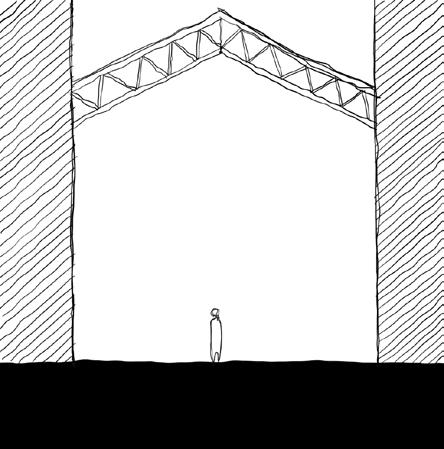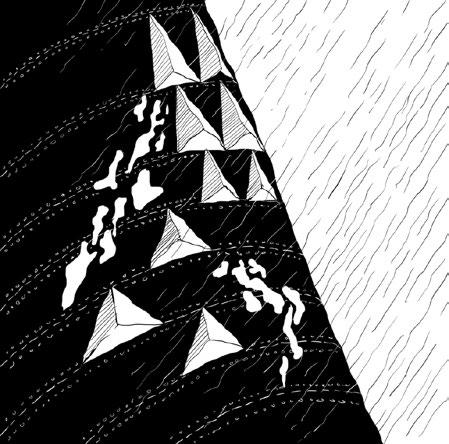
5 minute read
2. INDEPENDENT SYSTEM
Architecture normally runs as a closed independent system. e rst series of design practices aim to nd a way in the existing independent system to explain the thesis statement. It focuses on how to make one single architecture vanish and be reborn by itself into other meanings.
One-time vanish
Advertisement
Post-industrialism derelicts’ charm
Although the overall proposal aims to set up a vanishing cycle, the study begins with the one-time vanishing to discuss the possible metamorphosis of the space in the vanishing process. erefore, it is the process to see how space vanishes gently, peacefully, meaningfully and poetically.
e series sketches explained the eight main characters from the derelicts, which endow the philosophical value to the space. ese are the values which should be expressed through the vanishing process.
Composition Circulation




Mysterious

Visual Navigation Light & Shadow


Initiative Corresponding
Valuable precedents for generating one time vanishing:
Normally it will take more time for an independent system to make old space vanish, and new space emerge. And this process is more like an extension of a one-time vanish instead of setting up a material cycle.
33. Barasch, Ruin, 108 - 115. 34. Barasch, Ruin, 156 - 164.
Fig.19. e Factory photograph (1973).

PRECEDENT:
e Factory / Ricardo Bo ll33
It is a residential building born from a cement factory. e architect used decades years to introduce natural vanishing into the industrial building. e history and program evolve into new interpretations.

Fig.20. Zeitz Museum (2017).
PRECEDENT:
Zeitz Museum of Contemporary Art Africa34
e new project embeds perfectly with the past by directly using the old building as the main architecture. e program impacted the factory form but could use the original form to describe the new story. Here the old building comes alive in its new form.
Program:
As mentioned in ELABORATION 1, the limited speci c used program is the one that makes the factories hard to renovate. erefore, the more universal the program becomes, the more exible the space will be.
In this iteration, the program is designed to make some original machines operable. As the Newport power station used to burn a lot of fossil fuels to heat the water and gas, the rst program test made it evolve into a graveyard.
Following the matter change idea of the power station, the graveyard gradually became composed of several crematoriums, cemeteries, and chapels.




Step 1: Break the origin block space. Walls and chimneys all break into walls with openings. Step 2: is breaking keeps happening and brings di erent break strategies and objects, like leaving the mechanical structure of existing tanks. e program changes into an introduction function as a gallery to introduce the industrial history to the public.
Step 3: Space keeping detached and di erent interactions are generated during this process with inside-out space. e crematorium was introduced into the site with pavilions of cemetery gradually emerging. Step 4: Due to the opening of the space, the natural perturbation will bring landscapes inside the building.







Step 5: Space gradually vanished; the old factory no more existed and was replaced by a series of graveyards. e space is very open. Step 6: e vanishing continues; in hundred years, there will be no more buildings existing, but just landscape.

?Re ection here is this one-time vanishing will take hundreds of years to let material return back to nature. It is poetic, but will it actually be fast enough to match the frequent updating? Besides, not all the derelict could end up as graveyards.
Strategy:
To visualize the vanishing metaphor, the rst study aims to use gentle demolition as a solution.
e demolish methods are two main types: manual demolition and Bursting demolition. In this iteration, disassembly happens all the time to make the process controllable to allow di erent programs to come at di erent stages.
35. Christele Harrouk, “Edoardo Tresoldi and Studio Studio Studio Release Images of Wire Mesh Installation in Riyadh,” Archdaily, published December 17, 2019, https://www.archdaily.com/930380/edoardo-tresoldi-and-studio-studio -studio-release-images-of-wire-mesh-installation-in-riyadh.

Fig.21. Riyadh installation. (2019).
PRECEDENT:
Wire Mesh Installation in Riyadh35
Edoardo Tresoldi is an architect who aims to express architecture through the mesh. For the monumental celebration, for the memorial, no matter what program and functions are required, the ambiguity generated by space will always nd its way to adapt it.

Step 1: Stop the chimney and apply steel mesh surrounding the deconstruct locations. Workers will then only demolish in certain areas. Step 2: is process happens each 5 years, it runs as a long term demolish project. Step 3: e demolished material will be recollected in the vacancy of double layer mesh wall. e existence of them is to reveal the historical story of the site.



e independent system ends up with one-time vanishing does endow meanings in the process of vanishing, but vanishing here is an end with no reborn. e rebirth of the program will eventually go into nothing due to no more architecture and space.











